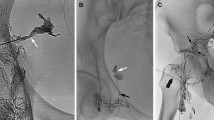Abstract
Purpose
To retrospectively evaluate the short-term outcomes of lymphangiography and lymphatic embolization in the treatment of pelvic lymphocele after radical prostatectomy in patients with prostate cancer.
Materials and Methods
The data of nine, consecutive patients who underwent lymphangiography and lymphatic embolization for pelvic lymphocele after radical prostatectomy with pelvic lymph node dissection (PLND) between January 2016 and May 2018, were retrospectively reviewed. Lymphangiography was performed through inguinal lymph nodes in order to identify the lymphatic leakage. When a leakage was found, lymphatic embolization was performed using a directly punctured fine needle at the closest upstream lymph node or lymphopseudoaneurysm and with N-butyl cyanoacrylate glue.
Results
Lymphangiography demonstrated extravasation and/or lymphopseudoaneurysm in all of these patients. A total of 13 sessions of lymphangiography and lymphatic embolization were performed. The median number of lymphangiography and lymphatic embolizations required to achieve clinical success was one (range, 1–3). Three patients underwent repeated embolization with successful results. The technical and clinical success rates were 100%, respectively. The median time to resolution was 7 days (range, 2–19 days). There was no recurrence and no procedure-related complications during the follow-up period (mean, 26 weeks; range, 8–77 weeks) in all patients.
Conclusions
Lymphangiography and lymphatic embolization are safe and effective for the management of pelvic lymphoceles after radical prostatectomy with PLND.


Similar content being viewed by others
References
Briganti A, Blute ML, Eastham JH, et al. Pelvic lymph node dissection in prostate cancer. Eur Urol. 2009;55:1251–65.
Messing EM, Manola J, Sarosdy M, Wilding G, Crawford ED, Trump D. Immediate hormonal therapy compared with observation after radical prostatectomy and pelvic lymphadenectomy in men with node-positive prostate cancer. N Engl J Med. 1999;341:1781–8.
Musch M, Klevecka V, Roggenbuck U, Kroepfl D. Complications of pelvic lymphadenectomy in 1,380 patients undergoing radical retropubic prostatectomy between 1993 and 2006. J Urol. 2008;179:923–9.
Khoder W, Trottmann M, Seitz M, et al. Management of pelvic lymphoceles after radical prostatectomy: a multicentre community based study. Eur J Med Res. 2011;16:280.
Karcaaltincaba M, Akhan O. Radiologic imaging and percutaneous treatment of pelvic lymphocele. Eur J Radiol. 2005;55:340–54.
Itkin M. Lymphatic intervention techniques: look beyond thoracic duct embolization. J Vasc Interv Radiol. 2016;27:1187–8.
Baek Y, Won JH, Kong T-W, et al. Lymphatic leak occurring after surgical lymph node dissection: a preliminary study assessing the feasibility and outcome of lymphatic embolization. Cardiovasc Interv Radiol. 2016;39:1728–35.
Baek Y, Won JH, Chang S-J, et al. Lymphatic embolization for the treatment of pelvic lymphoceles: preliminary experience in five patients. J Vasc Interv Radiol. 2016;27:1170–6.
Hur S, Shin JH, Lee IJ, et al. Early experience in the management of postoperative lymphatic leakage using lipiodol lymphangiography and adjunctive glue embolization. J Vasc Interv Radiol. 2016;27(1177–86):e1.
Srinivasa RN, Chick JFB, Patel N, Gemmete JJ, Srinivasa RN. Transinguinal interstitial (intranodal) lymphatic embolization to treat high-output postoperative lymphocele. J Vasc Surg Venous Lymphat Disord. 2018;6:373–5.
Chick JFB, Reddy SN, Nadolski GJ, Dori Y, Itkin M. Single-session endolymphatic glue embolization of lymphocele after heart transplantation. J Vasc Interv Radiol. 2016;27:929–30.
Kim SW, Hur S, Kim SY, et al. The efficacy of lymph node embolization using n-butyl cyanoacrylate compared to ethanol sclerotherapy in the management of symptomatic lymphorrhea after pelvic surgery. J Vasc Intervent Radiol. 2019;30:195–202.
Hill H, Srinivasa RN, Gemmete JJ, Hage A, Bundy J, Chick JFB. Endolymphatic ethiodized oil intranodal lymphangiography and cyanoacrylate glue embolization for the treatment of postoperative lymphatic leak after robot-assisted laparoscopic pelvic resection. J Endourol Case Rep. 2018;4:66–71.
Filippiadis DK, Binkert C, Pellerin O, Hoffmann RT, Krajina A, Pereira PL. Cirse quality assurance document and standards for classification of complications: the cirse classification system. Cardiovasc Interv Radiol. 2017;40:1141–6.
Ploussard G, Briganti A, De La Taille A, et al. Pelvic lymph node dissection during robot-assisted radical prostatectomy: efficacy, limitations, and complications—a systematic review of the literature. Eur Urol. 2014;65:7–16.
Ghazi A, Scosyrev E, Patel H, Messing EM, Joseph JV. Complications associated with extraperitoneal robot-assisted radical prostatectomy using the standardized martin classification. Urology. 2013;81(2):324–31.
Lee HJ, Kane CJ. How to minimize lymphoceles and treat clinically symptomatic lymphoceles after radical prostatectomy. Curr Urol Rep. 2014;15:445.
Gilliland J, Spies J, Brown S, Yrizarry J, Greenwood L. Lymphoceles: percutaneous treatment with povidone-iodine sclerosis. Radiology. 1989;171:227–9.
Kim J-K, Jeong Y-Y, Kim Y-H, Kim Y-C, Kang H-K, Choi H-S. Postoperative pelvic lymphocele: treatment with simple percutaneous catheter drainage. Radiology. 1999;212:390–4.
Akhan O, Karcaaltincaba M, Ozmen MN, Akinci D, Karcaaltincaba D, Ayhan A. Percutaneous transcatheter ethanol sclerotherapy and catheter drainage of postoperative pelvic lymphoceles. Cardiovasc Interv Radiol. 2007;30:237–40.
Caliendo MV, Lee DE, Queiroz R, Waldman DL. Sclerotherapy with use of doxycycline after percutaneous drainage of postoperative lymphoceles. J Vasc Interv Radiol. 2001;12:73–7.
Alago W, Deodhar A, Michell H, et al. Management of postoperative lymphoceles after lymphadenectomy: percutaneous catheter drainage with and without povidone-iodine sclerotherapy. Cardiovasc Interv Radiol. 2013;36:466–71.
Chin AI, Ragavendra N, Hilborne L, Gritsch HA. Fibrin sealant sclerotherapy for treatment of lymphoceles following renal transplantation. J Urol. 2003;170:380–3.
Shih J, Trerotola SO, Itkin M. The lymphocele PILL: a case report of percutaneous imaging-guided lymphatic ligation for the treatment of postsurgical lymph collections. J Vasc Interv Radiol. 2008;19:1781–4.
Author information
Authors and Affiliations
Corresponding author
Ethics declarations
Conflict of interest
The authors declare that they have no conflict of interest.
Consent for Publication
For this type of study, consent for publication is not required.
Ethical Approval
This is retrospective study, for this type of study formal consent is not required.
Informed Consent
This study has obtained IRB approval from our institution, and the need for informed consent was waived.
Additional information
Publisher's Note
Springer Nature remains neutral with regard to jurisdictional claims in published maps and institutional affiliations.
Rights and permissions
About this article
Cite this article
Chu, H.H., Shin, J.H., Kim, J.W. et al. Lymphangiography and Lymphatic Embolization for the Management of Pelvic Lymphocele After Radical Prostatectomy in Prostatic Cancer. Cardiovasc Intervent Radiol 42, 873–879 (2019). https://doi.org/10.1007/s00270-019-02209-6
Received:
Accepted:
Published:
Issue Date:
DOI: https://doi.org/10.1007/s00270-019-02209-6




